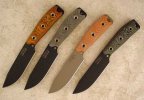- Joined
- Dec 29, 2008
- Messages
- 1,647
I really like to support custom knife makers. I think it's an awesome craft and there is too much mass production out there anyway. However I have one particular issue and it's not just an aesthetic problem but actually bugs me quite a bit when sharpening. And that's the edge near/at the ricasso. Here is a Fallkniven that shows how it should be

In most cases however, there is some irregularity close to the ricasso and most often the edge goes "outwards" if you guys understand what I mean. That gives problems to the whole sharpening process on flat stones, strops etc. To solve that problem, I have to grind away a lot of metal in that area before the edge becomes straight with the rest. I know some of you may now think why don't you use a narrow stone (rod) or a belt sander or such and don't worry about it and most of you that think that way also like recurves I believe which I don't at all for the same reason. So, why not just adding a "notch" at the end of the edge at the ricasso and get it over with? I am not even asking for discontinuation of all recurve productions
My two cents!
Andy

In most cases however, there is some irregularity close to the ricasso and most often the edge goes "outwards" if you guys understand what I mean. That gives problems to the whole sharpening process on flat stones, strops etc. To solve that problem, I have to grind away a lot of metal in that area before the edge becomes straight with the rest. I know some of you may now think why don't you use a narrow stone (rod) or a belt sander or such and don't worry about it and most of you that think that way also like recurves I believe which I don't at all for the same reason. So, why not just adding a "notch" at the end of the edge at the ricasso and get it over with? I am not even asking for discontinuation of all recurve productions
My two cents!
Andy







